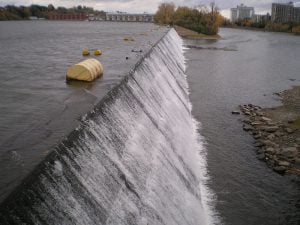
Science & Tech
Hydroelectricity in Quebec
Four experts discuss Hydro-Quebec and the driving force behind its gigantic network of generating stations
- 1614 words
- 7 minutes
This article is over 5 years old and may contain outdated information.
Science & Tech

FOR DECADES, hydro power utilities have had to contend with the dangerous work of performing routine maintenance on giant mechanical structures built in rapidly moving water. But as demand for electricity has grown sharply, utilities have cast around for smarter ways of performing routine underwater repairs without shutting down generators, slowing water flows or reducing reservoir levels.
For Hydro-Québec, the vast utility that’s dominated the province’s energy and industrial landscape for more than half a century, such problems read like opportunities for innovation. In recent years, for example, engineers at Hydro- Québec’s research institute invented and built underwater robots to help find and repair components found inside chutes well below the water level. Maski, a cube-shaped robot that’s about as large as a dishwasher but weighs more than 200 kilograms, can go down 270 metres on a long tether that allows technicians to remotely operate the device. It navigates using seven small thrusters.
Jerome Gossett, the principal director of the institute, says the 10-year-old technology allows Hydro-Québec maintenance officials to conduct inspections faster and more safely. The robot can also travel to parts of a dam where the churn and speed of the water are too risky for even the most experienced divers. Previously, the utility would have to shut down and empty intake valves so technicians could get into the guts of the equipment — a hazardous task that could take a unit out of operation for weeks instead of the two days required to do such inspections with the robot. Hydro- Québec says the robot generates savings of about $2 million a year.
It’s hardly the only technology-driven productivity enhancement emerging from the Canadian hydro sector. Scientists at Hydro-Québec’s research institute have plunged into the race to develop a long-range, lightweight battery for electric vehicles — a much soughtafter and long-promised innovation that would revolutionize the electric vehicle market, which is currently hampered by the relatively short range of conventional lithium-ion batteries.
Since the 1990s, Ontario Power Generation has rolled out an ambitious turbine upgrade program for its hydro stations, replacing machinery built in the 1950s and ’60s with state-of-the-art computer-operated equipment that pushes efficiency levels from the 85 per cent range to the 93 per cent range, according to Mike Martelli, the Crown corporation’s president of renewable generation and power marketing.
Ontario Power Generation’s investments have produced an additional 500 megawatts of power — enough to supply electricity to every home in Hamilton, Ont., with some to spare. Martelli says the utility expects to squeeze at least that much more out of its hydroelectric fleet over the next decade with the next round of replacements.
AT SOME POINT next year, residents of Ottawa and Gatineau will have a new, shared open space on a historic island overlooking a run of rapids in the middle of the Ottawa River, which separates the two cities. A public park and a pedestrian bridge will overlook the intake channel leading to a refurbished turbine-power complex and the fan-shaped Chaudière Falls.
When Hydro Ottawa announced plans last fall for the $150-million project to refurbish the Chaudière Falls generating station, Canada’s oldest hydroelectric facility still in operation, officials stressed its history and its cultural significance to First Nations of eastern Ontario.
To address the ecological impacts, Hydro Ottawa developed mitigation measures to protect the American eel, an endangered species. Greg Clarke, Hydro Ottawa’s chief electricity generation officer, says the utility has worked with federal and provincial officials to figure out ways to protect the eels. Between July and September, when the eels begin their migration downriver to the Sargasso Sea in the Caribbean, the plant’s intake chutes will be covered by temporary screens to prevent the animals from being sucked into the turbines. The design also calls for a fish passage to help the eels, and other fish, move downstream and an eel ladder to help them migrate upstream. The utility’s scientists predict these measures will boost the eels’ survival rate from 70 per cent to 98 per cent. Says Clarke: “This is going to be the first example in Canada on this scale.”
Are you passionate about Canadian geography?
You can support Canadian Geographic in 3 ways:

This story is from the June 2016 Issue

Science & Tech
Four experts discuss Hydro-Quebec and the driving force behind its gigantic network of generating stations

Environment
Carbon capture is big business, but its challenges fly in the face of the need to lower emissions. Can we square the circle on this technological Wild West?

Science & Tech
Canada has about 160,000 megawatts of untapped hydro power. How can we access it?

Science & Tech
Navigating the the collaborative future between First Nations and the Canadian hydro industry